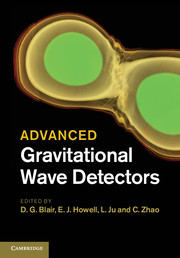Book contents
- Frontmatter
- Contents
- List of contributors
- Foreword
- Preface
- Introduction
- Part 1 An introduction to gravitational wave astronomy and detectors
- 1 Gravitational waves
- 2 Sources of gravitational waves
- 3 Gravitational wave detectors
- 4 Gravitational wave data analysis
- 5 Network analysis and multi-messenger astronomy
- Part 2 Current laser interferometer detectors – three case studies
- Part 3 Technology for advanced gravitational wave detectors
- Part 4 Technology for third generation gravitational wave detectors
- Index
4 - Gravitational wave data analysis
from Part 1 - An introduction to gravitational wave astronomy and detectors
Published online by Cambridge University Press: 05 March 2012
- Frontmatter
- Contents
- List of contributors
- Foreword
- Preface
- Introduction
- Part 1 An introduction to gravitational wave astronomy and detectors
- 1 Gravitational waves
- 2 Sources of gravitational waves
- 3 Gravitational wave detectors
- 4 Gravitational wave data analysis
- 5 Network analysis and multi-messenger astronomy
- Part 2 Current laser interferometer detectors – three case studies
- Part 3 Technology for advanced gravitational wave detectors
- Part 4 Technology for third generation gravitational wave detectors
- Index
Summary
This chapter focuses on data analysis, a central component of gravitational wave astronomy. After a short introduction to the field we discuss the techniques used to search for the three classes of gravitational wave signals. These include well predicted signals such as coalescing compact binaries, less certain signals such as those from supernovae, and the stochastic signals from gravitational wave backgrounds. We will finish by briefly discussing issues relevant to network detection.
Introduction
Observing gravitational waves requires a data analysis strategy that is in many ways different from conventional astronomical data analysis. There are several reasons why this is so. Gravitational wave antennae are essentially omni-directional, with their response better than 50% of the root mean square over 75% of the sky. Hence, data analysis systems will have to carry out all-sky searches for sources. Additionally, gravitational wave interferometers are typically broadband, covering three to four orders of magnitude in frequency. While this is obviously to our advantage, as it helps to track sources whose frequency may change rapidly, it calls for searches to be carried out over a wide range of frequencies.
In Einstein's theory, gravitational radiation has two independent states of polarisation. Measuring polarisation is of fundamental importance as there are other theories of gravity in which the number of polarisation states is more than two; in some theories dipolar and even scalar waves exist (Will, 1993). Polarisation has astrophysical implications too. For example, gravitational wave polarisation measurements can be very helpful in resolving the degeneracy that occurs in the measurement of the mass and inclination of a binary system.
Information
- Type
- Chapter
- Information
- Advanced Gravitational Wave Detectors , pp. 71 - 88Publisher: Cambridge University PressPrint publication year: 2012
